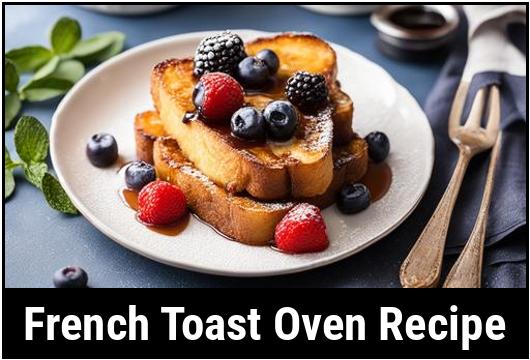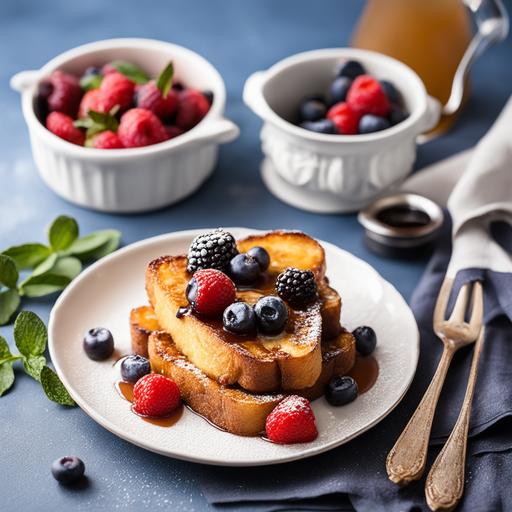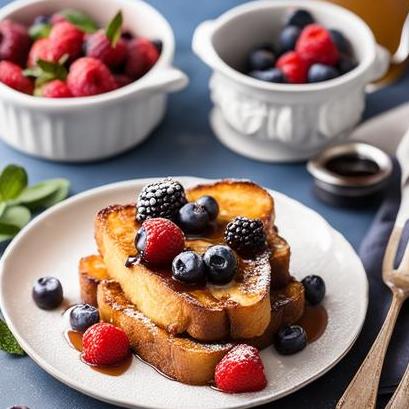
The Ultimate French Toast Oven Recipe Guide
French toast is a classic breakfast delight that never fails to satisfy the taste buds. It’s a perfect combination of fluffy bread soaked in a sweet mixture of eggs and milk, cooked to golden perfection. While stove-top cooking is the traditional method for making French toast, using the oven can offer an effortless and consistent result. In this comprehensive guide, we will explore the food science behind French toast, culinary details, selecting the right ingredients, cleaning tips, preparation methods, variations to try, and helpful hints to achieve the perfect doneness level. So let’s dive in and uncover the secrets to making the most delectable French toast in the oven!
The Science behind French Toast
French toast is simple yet satisfying, and understanding the science behind it can help us create the perfect balance of flavors and textures. The primary components of French toast are bread, eggs, and milk. Why do we need these ingredients, and how do they work together to create that mouthwatering transformation?
Bread Selection
Choosing the right bread is crucial for a delightful French toast experience. Opt for a bread that is slightly stale or a day old, as it will soak up the custard mixture better without becoming soggy. Breads with a more substantial crumb, such as brioche, challah, or French baguette, work exceptionally well. Their dense structure ensures that the custard mixture is absorbed evenly, resulting in a fluffy interior and a crispy exterior.
The Role of Eggs
Eggs play a vital role in the custard mixture, binding the ingredients together and providing structure. The proteins in eggs coagulate during baking, contributing to the final texture of the French toast. Additionally, eggs add richness and a velvety smoothness to the soak, resulting in the perfect custard-like consistency.
Milk or Cream?
Milk serves as the liquid element of the custard mixture. It provides moisture to the bread, making it tender and flavorsome. Opt for whole milk or a combination of milk and cream for a luscious and creamy texture. If you prefer a lighter option, low-fat milk can also be used without compromising the taste.
Culinary Details: Cleaning and Preparation
Before we embark on our French toast-making journey, it’s essential to ensure our kitchen tools and equipment are clean and ready for use. Here are a few cleaning tips to keep in mind:
-
Utensils: Gather a mixing bowl, whisk, baking dish, and a spatula. Ensure they are clean, dry, and free from any lingering odors or previous food residues that might affect the taste of the French toast.
-
Baking Dish: Choose a baking dish large enough to accommodate your bread slices in a single layer, ensuring they have enough room to absorb the custard mixture evenly. Grease the dish lightly with butter or cooking spray to prevent sticking.
Once everything is sparkly clean and ready, let’s move on to the preparation process!
Preheat the Oven
Preheating the oven ensures even baking and a consistent final result. Set your oven temperature to 375°F (190°C) and allow it to come to full heat while you prepare the custard mixture.
Custard Mixture Preparation
To prepare the custard mixture, follow these steps:
-
Crack the eggs into a mixing bowl, ensuring no eggshells have fallen in. Start with four large eggs, adjusting the quantity based on how many slices of bread you plan to use.
-
Whisk the eggs vigorously until they are well-combined, creating a smooth mixture.
-
Gradually pour in the milk, whisking continuously. For a richer flavor, replace a portion of the milk with heavy cream.
-
Sweeten the mixture to your liking, adding sugar, cinnamon, vanilla extract, or any other desired flavorings. Whisk well to incorporate the ingredients fully.
Tips for Perfectly Baked French Toast

Now that we have our custard mixture ready, it’s time to move onto the baking process. Follow these helpful tips to ensure your French toast turns out beautifully every time:
-
Soaking Time: Properly soaking the bread slices in the custard mixture is crucial for even flavor distribution. Let the bread slices sit in the mixture for at least 15-20 minutes, ensuring they are entirely saturated.
-
Bread Placement: After soaking, place the soaked bread slices in a greased baking dish, making sure to leave space between each slice. If desired, sprinkle some additional spices or sugar on top for added flavor and texture.
-
Even Browning: To achieve a golden-brown color with a delightful crunch, be sure to flip the bread slices halfway through baking. This will ensure both sides are evenly toasted and deliver a satisfying contrast between the soft interiors and crispy exteriors.
-
Parchment Paper: Consider lining your baking dish with parchment paper. This not only makes cleanup easier but also prevents the French toast from sticking to the dish, allowing for effortless removal.
Variations to Satisfy Your Taste Buds

French toast is incredibly versatile, allowing you to customize the flavors based on your preferences. Here are a few variations that will take your French toast experience to the next level:
1. Stuffed French Toast
Transform your French toast into a delightful surprise by adding a flavorful filling. Think cream cheese, jam, nutella, or fresh fruits. Simply sandwich the chosen filling between two soaked bread slices before baking, sealing the edges to prevent leakage. The result? A decadent French toast with a gooey and delicious center.
2. Savory French Toast
French toast doesn’t always have to be sweet. Experiment with savory versions by adding ingredients like grated cheese, herbs, spices, or cooked bacon. Incorporating savory elements creates a unique twist on this classic dish, making it a perfect option for brunch or breakfast-for-dinner.
3. Fruit Infusion
Incorporate your favorite seasonal fruits into the French toast. Add sliced bananas, berries, or even diced apples to the custard mixture before soaking the bread slices. These fruit-infused variations yield a burst of fruity flavor with every bite, making breakfast a refreshing and nutritious experience.
Ensuring the Perfect Doneness

The final touch in achieving amazing French toast is nailing the doneness level. Overcooking or undercooking can lead to less-than-thrilling results. Here are a few ways to check for that perfect sweet spot:
-
Touch Test: Press gently on the center of a cooked bread slice. If it springs back and feels firm to the touch, it is likely fully cooked. A soft, squishy texture indicates it needs more time in the oven.
-
Color Indicator: Look for a golden-brown color on both sides of the French toast. This visual cue often indicates that the toast has achieved the desired level of doneness.
-
Internal Temperature: If you prefer a more precise approach, you can use a food thermometer to check the bread’s internal temperature. Aim for around 160°F (70°C) to ensure perfection.
Recipe: French Toast Oven Style

Below is a detailed recipe to help you create mouthwatering French toast in the oven:
Ingredients:
-
4 large eggs
-
1 cup whole milk (or a combination of milk and cream)
-
2 tablespoons sugar (adjust to taste)
-
1 teaspoon vanilla extract
-
Pinch of salt
-
8 slices of bread (brioche, challah, or French baguette)
Instructions:
-
Preheat your oven to 375°F (190°C) and grease a baking dish lightly.
-
In a mixing bowl, crack the eggs and whisk vigorously until well-combined.
-
Gradually pour in the milk while whisking continuously.
-
Add sugar, vanilla extract, and a pinch of salt to the mixture, whisking until thoroughly incorporated.
-
Dip each bread slice into the custard mixture, ensuring they are fully soaked on both sides.
-
Let the soaked bread slices rest in the mixture for 15-20 minutes, allowing them to absorb the flavors.
-
Place the soaked bread slices on the greased baking dish, leaving enough space between slices.
-
Bake for approximately 20 minutes, flipping the slices halfway through to ensure even browning.
-
Once the French toast turns golden-brown on both sides, remove from the oven.
-
Serve warm with your favorite toppings such as maple syrup, fresh fruits, powdered sugar, or whipped cream.
Conclusion
With our comprehensive guide, you now possess the knowledge and techniques to create spectacular French toast in the oven. From selecting the perfect bread to preparing a delectable custard mixture, and exploring various flavor variations, your breakfasts are about to reach new heights. Remember to pay attention to the doneness of your French toast and trust your senses to deliver that perfect balance between a fluffy interior and a crispy exterior. So put on your apron, preheat your oven, and savor the joy of indulging in a slice of irresistibly delicious French toast. Bon appétit!
Sources
FAQS On French Toast Oven Recipe
What Are The Ingredients Needed For A French Toast Oven Recipe?
To make french toast in the oven, you will need bread, eggs, milk, vanilla extract, cinnamon, and a sweetener such as sugar or maple syrup.
How Long Does It Take To Cook French Toast In The Oven?
The cooking time for french toast in the oven typically ranges from 20-25 minutes, depending on the thickness of the bread and the desired level of doneness.
Can I Make A Large Batch Of French Toast In The Oven?
Yes, you can easily make a large batch of french toast in the oven by using a large baking sheet or casserole dish and adjusting the ingredients accordingly.
Can I Prepare The French Toast In Advance And Bake It Later?
Yes, you can assemble the french toast in a baking dish, cover it with plastic wrap, and refrigerate it overnight. The next morning, simply remove the plastic wrap and bake as directed.
Are There Any Variations To The Traditional French Toast Oven Recipe?
Yes, you can customize your french toast by adding toppings such as sliced fruits, nuts, or chocolate chips before baking. Additionally, you can experiment with different types of bread, such as brioche or challah, for a unique flavor.



